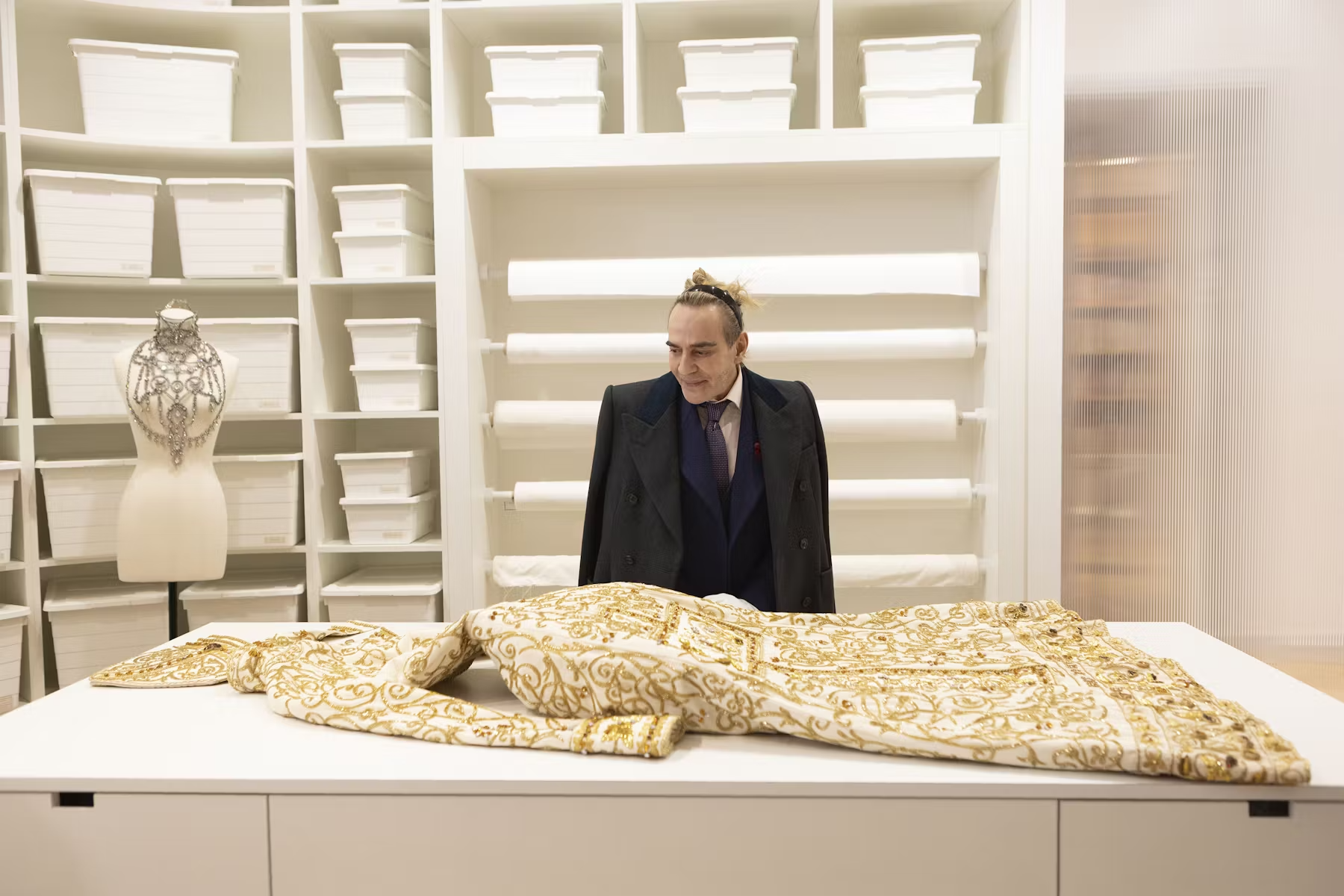In the documentary film High & Low: John Galliano, director Kevin Macdonald allows fashion enthusiasts to witness a new artistic journey, one that includes both moments of triumph and failure for the iconic figure in the fashion world – John Galliano. And the question arises: Should art be separated from the artist?

Even if you’ve never set foot in a movie theater, you might have already witnessed the opening scenes of the new documentary about John Galliano, High & Low, premiered on Mubi. The film begins with the “forgettable” and most widely circulated moment of the designer’s career. In 2011, at the La Perle bar in Paris, John praised Hitler and condemned Jews. The incident, as Galliano refers to it, was filmed and spread across the internet. Galliano was fired from his position as creative director of Dior despite receiving much praise just before the unveiling of the Fall 2011 collection, condemned by online fans, and criticized by Taran Killam on Saturday Night Live.
It was a dark time in the fashion community and particularly painful for Jewish and Asian communities, many of whom grew up admiring a creative genius like Galliano. The film’s director, Kevin Macdonald, an Oscar-winning Scottish filmmaker, completed the film over the past few years, stating: “I decided early on that I had to start with his bombastic statement. If I didn’t, people would say, ‘Oh, they’re just whitewashing it. They want us to think he’s a genius, and then it’ll be all the controversial stuff.’ But no, you can’t make a film about John Galliano that only starts with beauty.”
Instead, Macdonald approaches Galliano’s life very realistically, much like how he approached his previous fictional horror films (The Last King of Scotland and State of Play): like a psychological detective. “Galliano is a mysterious, enigmatic character. The extraordinary thing for me is that he doesn’t understand why he did what he did! My job is to find out what happened.”
Macdonald begins with Galliano’s troubled childhood in Gibraltar, Spain. Surprisingly, he grew up on a street named Serfaty’s Passage – a street honoring the Jewish residents of the country, most of whom were stoned, drowned, or burnt at the stake in the Inquisition Court. “Many escaped, including my ancestors, who fled to Africa.” Ironically, Macdonald himself is a child of the Jewish diaspora and a descendant of Holocaust survivors (despite his distinctly Scottish accent).
Macdonald’s own roots and childhood, particularly his grandfather’s involvement in producing the famous ballet The Red Shoes, played a significant role in shaping this director’s artistic curiosity. Macdonald was looking for a means to explore “cancel culture” and answer the question of who deserves forgiveness when our transgressions are exposed. “I came up with the idea during lockdown,” he said. “Many people have been ‘canceled,’ but you never know what happens next. Have they developed? Have they changed? Have they disappeared forever? A friend said they knew Galliano and I should talk to Anna Wintour, because she’s like his guardian angel.”
After receiving the famous AW OK, Macdonald visited the designer in Paris, and in their direct meeting, they reached a mutual agreement. “Honestly, I think we were both assessing each other!” Macdonald laughed. “I want to make a truly interesting and complex film about all of these issues. He wants a fair, good film made about him so that he can empathize with it. I don’t know why he didn’t want a ‘fashion’ person to do it. Maybe you already know too much?”
Galliano then allowed Macdonald full access to his life, including his home, studio, and famous fashion circle friends like Naomi Campbell, Kate Moss, Charlize Theron, Penélope Cruz, and Wintour herself. The director said that Galliano appeared to want a film made about his life, although he might not admit it. “I know not everyone will forgive me, but I want people to understand me. Once they have the information, they can decide,” Galliano said.
To start framing John Galliano’s story (literally), Macdonald attached a mirror to his camera, allowing Galliano to communicate with the director through eye contact rather than a blank lens. He brought it to a village in southern France, where Galliano resides in a “decadent” villa above the cliffs. “I thought of the famous scene with Napoleon when Galliano was on the rocks overlooking the sea. It’s really interesting, but not surprising because ultimately, he’s a master storyteller.”
But while Napoleon died in exile, Galliano is currently undergoing his second ascent to the “fashion stratosphere” thanks to his admirable performance at Maison Martin Margiela – something Macdonald witnessed firsthand during the filmmaking process. Macdonald admitted: “Before High & Low, I had a fairly dismissive view of fashion. I thought it was very frivolous. Watching him work at Margiela and then looking at the archive of his work at Dior, I realized that fashion reflects society at any given time. Besides skill, craftsmanship, and artistry, fashion can also tell the most astonishing stories and create the most vivid characters. I was surprised that John hasn’t made costumes for film.”
As for whether Hollywood allows Galliano to return to his orbit, especially as an official collaborator, he said: “Some celebrities absolutely don’t want to talk about their relationship with Dior or Galliano, and to be fair, that’s okay.” Some people who worked closely with John don’t want to see him again. “Others agree to talk to me, but basically, they don’t say anything. They want to show support, but they can’t give me what I need.”
Can Macdonald overcome Galliano’s “buried” moments, not only as a Jew but also as an artist who often merges beauty and fear into the same frame? After all, he’s the one who created How I Live Now, an independent horror film following Saoirse Ronan through nuclear apocalypse and subsequent societal collapse. “It’s funny you ask because in a way, the two films are very similar!” Macdonald exclaimed. In both cases, there are “ticking time bombs” ultimately destroying something beautiful.

Related post
Rihanna and Dior: The Reunion of Fashion Icons and Luxury Brands?
Will fashion enthusiasts witness the long-awaited encounter between fashion icon Rihanna and Dior after 9 years? Recently, according to Business of Fashion – a specialized
Why Rihanna Was Honored as the “Queen of Street Style” at Fashion Weeks in 2014?
Before Zendaya claimed the CFDA’s “Fashion Icon” title in 2021, before Doja Cat, Bella Hadid, or Julia Fox shook up the street style scene at
Remembering Fashion Designer Iris Apfel, Style Icon Who Passed Away at Age 102
Iris Apfel, an icon of the 80s, gained fame in the fashion industry for her unique style, especially her oversized cat-eye glasses. Meet Iris Apfel,
Behind the Controversies of Khy – Kylie Jenner’s Brand
Khy – the brand founded by Kylie Jenner – garnered much attention upon its launch, but it was soon followed by a series of allegations
“The Boyfriend Effect”: How Has the “Timothee Effect” Influenced Kylie Jenner’s Wardrobe?
What made “hot mom” Kylie Jenner decide to reboot her fashion era? The answer can only be the “Timothee Effect.” Summary of Content “Old money”: